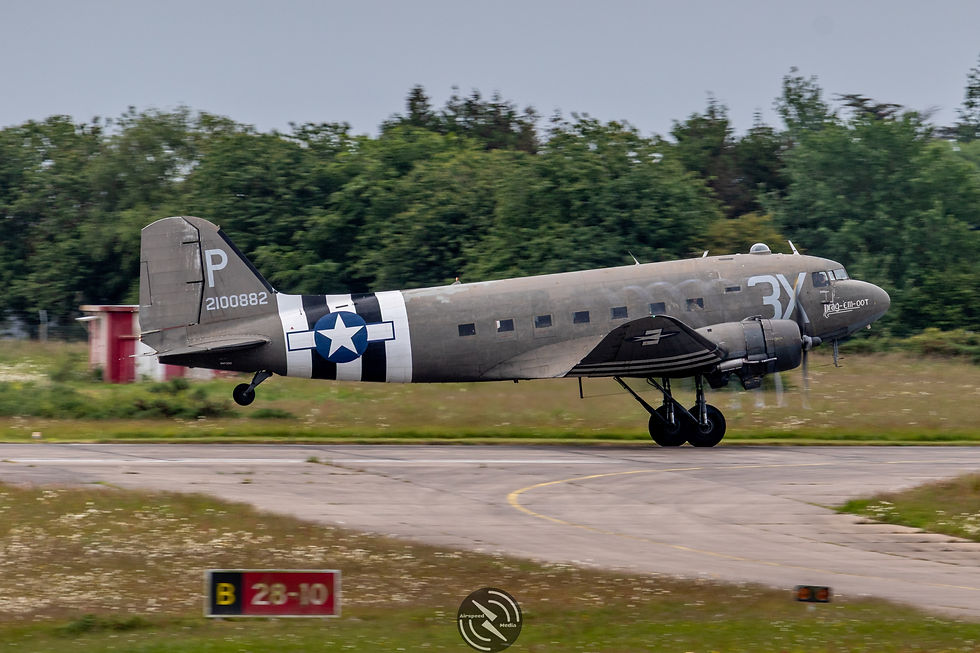D-Day 81 - Low level with the USAF over Normandy
- Mike Lintott-Danks
- Aug 14
- 5 min read
On the 5th June Airspeed Media had the opportunity to fly with the U.S. Air Force 86th Airlift Wing, based at Ramstein Air Base, as they took part in the D-Day 81st anniversary flypast over the Normandy beach landings.
‘American Airmen, along with U.S.-based aircraft and personnel, will participate in flyovers, ceremonial tributes, joint airborne operations and community engagements that honor those who took part in Operation Overlord—the largest air, land and sea invasion in history. These Airmen are a part of Joint Task Force 81, consisting of more than 600 U.S. Airmen, Soldiers, and Sailors from roughly 17 units historically linked to D-Day and scheduled to participate in over 90 commemorative events throughout the Normandy region.’ https://www.usafe.af.mil/News/Article-Display/Article/4203658/usafe-afafrica-to-commemorate-81st-anniversary-of-operation-overlord-in-normandy/

Seven 86th AW Lockheed Martin C-130Js, including Air Mobility Command aircraft, were based out of Cherbourg-Manche Airport in Northern France along with a Koninklijke Luchtmacht C-130H which were part of the flypast over the Normandy beaches on the 6th June.
Along with the C-130Js there were a pair of Douglas Dakotas which dropped paratroopers over the beaches on the 6th June. These were ‘Drag-em-oot’ flown by Aero Legends and ‘Ready 4 Duty’ flown by Commemorative Air Force, Lancaster, Texas.

‘Drag-em-oot’
‘This Douglas C-47 c/n 19345, was delivered to the United States Army Air Force on 28 December 1943 and had serial 42-100882 assigned. She joined operations with 87th Troop Carrier Squadron based at Greenham Common in England equipped as glider pick up, her crew named her Drag ’em Oot (slang for ‘Drag Them Out’).
She participated in the air assault during D-Day when at 00:46 on 06 June 1944 she dropped 18 paratroopers of the US 82nd Airborne Division just behind the Normandy beach heads, near St. Mere Église. She returned safe to the UK and after a second mission that very same day, she started to resupply the troops in France.
In September 1944 she was transferred to the RAF, designated a Dakota C.3 and assigned the British serial TS422. Once with the RAF she was assigned to Number 1 Heavy Glider Servicing Unit, attached to 38 Group RAF at Netheravon, Wiltshire. The RAF wanted to have a specialist glider recovery unit and TS422 started recovering Horsa assault gliders from the Normandy beach heads as soon as she joined the RAF. The unit recovered about 40 Horsa’s prior to Operation Market Garden. TS422 herself was just like the Horsa’s she recovered from the Normandy beaches, in action during the biggest paradropping in history: Operation Market Garden in September 1944. During this mission the pilot must have been severely wounded considering this Dakota was found to have signs of 12 bullet holes on the top of her cockpit and nose; probably caused by being attacked by a German fighter at some point but this Dakota warbird could take a beating. She was repaired and in August 1945 she joined 435 Squadron of the Royal Canadian Air Force which had just returned from Burma to the UK.
After the war ended the Dakota left for Canada, where she served with the RCAF as a trainer, a transport and whilst equipped with skis and jato rockets, as a search and rescue aircraft.
After her fruitful military career she ended up in the USA, serving with various civilian companies, being registered as N5831B. She was then grounded for a few years until Paddy Green found her in Arizona upon his search for a C-47 to be restored as a WW2 veteran.Following an inspection (plenty of DC-3 / C-47 hulks around but most are in deplorable shape when inspected thoroughly) she was purchased and prepared to a condition suitable for the long ferry flight back to England. The flight to Liverpool took 7 days and 35 hours flying time, but occurred without any technical problems.
Once in the UK she was registered N473DC and repainted in the livery she now appears in: the original markings as worn during her missions on D-Day 1944 with USAAF serial 42-100882 and coded 3X-P, nicknamed Drag ’em Oot (slang for ‘drag them out’) then piloted by Bill Allin.’ https://www.aerolegends.co.uk/the-aircraft/

‘Ready 4 Duty’
‘R4D-6S was no mere passenger carrier. She was built as a warbird. Our R4D-6S was modified to carry depth charges on external racks mounted under the fuselage between the main landing gear. She was assigned to the U.S. Navy Atlantic Special Service Squadron and conducted airborne search radar and sonar evaluation as well as training airborne specialists and operators. "Ready 4 Duty" served in the Caribbean from Texas to Guantanamo, Cuba; in South America as far down as Rio; across the South Atlantic to Dakar; in the eastern Atlantic up to Baffin Bay and northern Newfoundland; and across the northern hemisphere to Greenland and Iceland. During operational patrols in February 1945, our R4D was one of 20 in a squadron that surprised a surfaced German U-Boat off the coast of Brazil and sank it. After the War's end, the aircraft was retained in service and assigned to Naval Headquarters Berlin. Later, it returned to the U.S. and served in an electronics warfare training role. Our R4D is now configured to demonstrate several World War II history lessons, including sub-chaser, transport, hospital, and jump aircraft.’ https://commemorativeairforce.org/aircraft/156
The USAF C-130Js flew as a four ship over the landings on the 5th June which saw two flights, am and pm, allowing for low level ‘tail chase’ training across the Normandy region with additional formation practice over various location including many of the cemeteries across the area.
‘D-Day was a monumental, high-risk operation that relied on unprecedented coordination between Allied air, land and sea forces. Allied aircraft provided deep-strike missions and close air support that enabled the landings and blunted enemy resistance. The success of Operation Overlord created the foundation for the stability and security that Europe enjoys today. D-Day was a turning point in a brutal global conflict that came at the staggering cost of nearly 10,000 Allied casualties. The victory preserved liberty, democratic values and human dignity—and it stands as a lasting symbol of Allied strength and unity.’ https://www.usafe.af.mil/News/Article-Display/Article/4203658/usafe-afafrica-to-commemorate-81st-anniversary-of-operation-overlord-in-normandy/
The aircraft that were based out of Cherbourg-Manche airport were: -
U.S. Air Force 06-4631/05-3146/07-8614/07-46311/15-5822 +2 C130Js. The two unmarked C-130Js had recently had their markings removed in line with the Air Mobility Command directive to remove all markings from their aircraft due to operational security.
G781 – C-130H 336 Sqn, based out of Endhoven.
Thank you to D. Lee PA, CIV USAFE, Captain M. Hardy, PA USAFE, and the crew of 07-46311 for the opportunity to fly with the 86th AW over the Normandy landings.




















































Comments